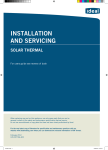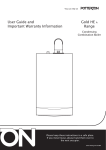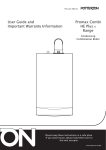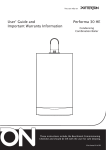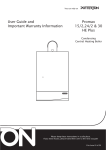Download Baxi Potterton Solar Thermal Domestic Hot Water System Solar Installation guide
Transcript
Please read these instructions before installing or commissioning. Potterton Solar - Solar Thermal Domestic Hot Water System should only be installed by a competent person. Please leave these instructions with the user for safe keeping. Installation Guide - In Roof Flat Plate Solar Collector Mounting Potterton Solar - Solar Thermal Domestic Hot Water System © Baxi Heating UK Ltd 2007. © BAXI Heating UK Ltd 2007. All rights reserved. No part of this publication may be reproduced or transmitted in any form or by any means, or stored in any retrieval system of any nature (including in any database), in each case whether electronic, mechanical, recording or otherwise, without prior written permission of the copyright owner, except for permitted fair dealing under Copyrights, Designs and Patents Act 1988. Applications for the copyright owner’s permission to reproduce or make other use of any part of this publication should be made, giving any details of the proposed use to the following address: The Company Secretary, BAXI Heating UK Ltd,The Wyvern Business Park, Stanier Way, Derby DE21 6BF. Full acknowledgement of author and source must be given. WARNING: Any person who does any unauthorised act in relation to a copyright work may be liable to criminal prosecution and civil claims for damages. 2 Potterton Solar - Solar Thermal Domestic Hot Water System Index 3 Index 4 General Safety information 6 Installation of in roof flat panel solar collector Lifting the panel General assembly notes Mounting kit parts list - Slate and Flat Tile Suggested attachment points In roof mounting 19 Spares Potterton Solar - Solar Thermal Domestic Hot Water System 3 1.0 1.1 General Safety information In order to reduce the number of deaths and major accidents attributable to work at height, the Health and Safety Executive has introduced comprehensive regulations and guidance that should be followed by all businesses working at height. We consider in the following paragraphs some of the main features of the regulations and guidance.This is, however, only a limited summary and it is recommended that all businesses planning on undertaking solar water heating installations obtain a copy of the regulations and guidance issued by the Health and Safety Executive and carefully consider the contents. The regulations and guidance state that you are required to carry out a risk assessment for all work conducted at height and to put in place arrangements for: • Eliminating or minimising risks from work at height. • Safe systems of work for organising and performing work at height. • Safe systems for selecting suitable work equipment. • Safe systems for protecting people from the consequences of work at height. The regulations and guidance highlight a hierarchy for safe work at height: • Avoid the risk by not working at height if practicable. • Prevent falls, where it is not reasonably practicable to avoid work at height; you are required to take suitable and sufficient steps to prevent the risk of a fall including selecting the most suitable work equipment (in accordance with the regulations). • Mitigate the consequences of a fall; where the risk of a person or object falling still remains, take suitable and sufficient measures to minimise the distance and consequences of any fall. Collective protection measures, such as guard rails on scaffold, should be given priority over personal protection measures, such as safety harnesses. Within the regulations’ framework, you are required to: 1) Assess the risk to help you decide how to work safely. 2) Follow the hierarchy for safe work at height (i.e. avoid, prevent and mitigate). 3) Plan and organise your work properly, taking account of weather conditions and the possibility of emergencies. 4) Make sure those working at height are competent. 5) Make use of appropriate work equipment. 6) Manage the risks from working on or around fragile surfaces and from falling objects. 7) Inspect and maintain the work equipment to be used and inspect the place where the work will be carried out (including access and egress). When preparing to install a solar water heating system, it is required that you perform a risk assessment in relation to work at height and plan how you will organise your work, taking into account the site, the weather conditions and the experience and competence of colleagues or contractors who may be working at height with you. 4 Potterton Solar - Solar Thermal Domestic Hot Water System 1.0 General Risk Assessments The HSE has published a number of very useful free publications that advise how to undertake risk assessments. Two of these that you should obtain are: Five Steps to Risk Assessment. A Guide to Risk Assessment Requirements. The five steps outlined in the HSE leaflet are: Step 1: Look for the hazards This will mean looking at the site and identifying significant hazards.These could be features such as a steep roof, a fragile surface where the collectors may be mounted, uneven ground or obstructions where access to the roof might be required. Step 2: Decide who may be harmed and how This might mean considering the particular risks that young workers or trainees might face and thinking about the residents of the household or visitors who could be hurt by your activities. Step 3: Evaluate the risks and decide which precautions should be made.You should consider how likely it is that each hazard will cause harm, decide which precautions you might take and then assess, after you have taken those precautions, whether the remaining risk will be high, medium or low.Where you identify remaining risks, you should consider which further action you could take to control the risks so that harm is unlikely. Step 4: Record your findings If you have fewer than five employees you do not need to write anything down, though it is useful to keep a written record of what you have done. If you employ five or more people you must record the significant findings of your assessment.You must also tell your employees about your findings.You need to be able to show that a proper check was made, that you considered who might be affected, that you dealt with all the obvious significant hazards, that the precautions you propose are reasonable and that the remaining risk is low. Step 5: Review your assessment if necessary Each solar water heating installation may bring its own challenges and present its own particular hazards.You should therefore be careful not to rely on a “standard” risk assessment for installing a solar water heating system in a house, but review the particular hazards for each new situation.The issue of work equipment must be considered, but at the preparation stage you should consider where scaffold or other access equipment might be positioned and look out for any obvious obstacles to this, such as a conservatory or porch. In addition to the risks associated with work at height, you should also consider the risks associated with lifting and carrying solar collectors, using electric drills and using blow lamps or blow torches for soldering.This is not an exclusive list and you should consider all aspects of the proposed installation to assess whether there are additional risks that need to be taken into account. Potterton Solar - Solar Thermal Domestic Hot Water System 5 2.0 Installation of solar collector Fig. 1 2.1 Lifting the panel Do not lift the collectors by the connections. Refer to Section 2.2 of the Installation Guide Solar Collector Panel specifications for details of the dimensions and weight of each panel. Carrying/lifting straps must be securely fastened to the main framework of the panel. A lifting point is provided (see Fig. 1). Point impact and loading of the glass panel must be avoided.The collector must not be installed if the glass panel is damaged in any way. 6 Potterton Solar - Solar Thermal Domestic Hot Water System 2.0 2.2 Installation of solar collector General assembly notes These instructions relate to the installation of the Potterton Solar in roof flat plate solar collector panels. Parts are provided for fixing to profiled, flat or slate tile roofs, not all parts will be required for each roof type. Refer to the parts list for each roof type to establish the correct components that need to be used in each case. All other equipment must be installed as per detailed in the Potterton Solar Installation Guide. Use only Potterton Solar mounting systems. Use of other brackets/mounting systems will invalidate the warranty and may result in an insecure and dangerous panel installation. The mounting battens must be fixed to the roof structural members.They must never be fixed to roofing laths. If suitably positioned structural members are not available or, if they are of a section that may be weakened by the inserting of the fixing screws, additional noggins should be inserted between the structural members. These must be at least the same cross section as the structural member. Use only the corrosion resistant fastenings supplied. Holes through any roof waterproofing materials should be sealed with an appropriate UV and weather resistant sealant. Fig. 2 Noggin Rafter Structure The collectors may only be mounted on sufficiently load-bearing roof surfaces and substructures. It is essential that the structural load-bearing capacity of the roof and the substructure must be assessed before mounting the collectors. Particular attention should be paid to the quality of the (timber) substructure in terms of the stability of the screw joints necessary for installing the collector mounting brackets. Where roof structure is not strong enough noggins must be inserted to accept fixing screws.The roof structure must be able to take the wind and snow loads that can occur. (Note: 1m2 powder snow ~ 60kg / 1m2 wet snow ~ 200kg).The assessment should also take into account any special features of the particular site that could lead to increased loads (air jets or eddy formations, etc).There must be at least 1m distance from roof ridging or edges. The panels must be weatherproofed using the flushing kit provided. Lightning protection / Equipotential bonding of the building It is not necessary to connect collector arrays to the lightning protection of the building. For installations on metal substructures at the installation site, authorised lightning protection specialists must be consulted. The metal pipes of the solar circuit must be earth bonded to the main earthing circuit by means of a conductor (green/yellow) with a cross-section of at least 6mm2. Potterton Solar - Solar Thermal Domestic Hot Water System 7 2.0 Collector panels must be connected in series.The connections are 1” BSP female union connections. All connecting pipe work and fittings must be of a suitable metal; either copper, brass or stainless steel. Soft soldered joints must not be used.Any seals or sealing compounds must be resistant to temperatures of up to 150°C and be resistant up to a 50% glycol/water mix. Fig. 3 North Angle of tilt 90° 90° 80° 80° 70° 70° 60° 60° 50° 50° 40° 40° 30° 30° 20° 20° 10° 10° West East S.W. S.E. 0-5% 5-10% Connections When tightening the connections, always apply counter-pressure with a wrench or another spanner to prevent damage to the absorber. Collector inclination The collector is suitable for angles between 15° (minimum) and 75° (maximum). The roof aspect should ideally face South, however orientations between 30° East and 40°West of South are acceptable. Fig.3 shows the efficiency loss for varying angles of inclinations and roof orientation. South less than optimum by Installation of solar collector 10-20% Solar fluid The Potterton Solar collector panels MUST be protected with a water/glycol heat transfer fluid. Use only the fluid supplied with the system which is supplied premixed to a concentration of 40% glycol / 60% water.Top ups can be made with water but the glycol concentration must not be allowed to fall below 30% or inadequate frost protection will be given. Systems found to have lower glycol concentrations will not be covered by the warranty. 2.3 Mounting kit parts list. A. Installation batten 30x40x2450 1 panel 2 panels 1 (cut in half) 2 B. Attachment brackets 4 5 C. Self tapping screws 5x60 16 20 D. Connection bend E. Flat gasket F. Lower flashing (left and right hand corner and extension) Not required 1 2 2 LH & RH corner LH & RH corner & ext. Note: Flashing for slate and flat tile roofs does not have corrugated lead skirt G. Left and right hand side flashing 2 2 H. Left and right hand side cover strips 2 2 I. Sealed plumbing screws 4.5x35 8 9 Not required 1 3 5 J. Middle cover strip K. Sealed plumbing screws 3.9x13 L. Wooden support board and wedges 1 1 M. Self tapping screws 6x120 8 8 LH & RH corner LH & RH corner & ext. O. Metal retainers and roofing nails 10 12 P. Foam sealing strip (1m lengths) Cut to suit Cut to suit N. Upper flashing (left and right hand corner and extension) 8 Potterton Solar - Solar Thermal Domestic Hot Water System A B C D E F G H I J K L M N O P Potterton Solar - Solar Thermal Domestic Hot Water System 9 2.0 2.4 Fig. 4 Installation of Solar Collector Suggestion for attachment points Cut installation battens to 1 metre length Single panel installation Attachment bracket (approximate positions) Double panel installation 10 Potterton Solar - Solar Thermal Domestic Hot Water System 1 2.0 2.5 1: 2a Installation of Solar Collector In Roof mounting Remove roof covering according to the collector surface area being installed. Width: approx 1.25m per collector + 1.5m. Height: approx 3.0m. 2a: Attach the lower support batten using self tapping screws supplied 5x60mm. Note: fixing dimensions in 2b and 2c. Lower support batten 2b Lower support batten 2b: Dimension A. 80mm for profiled tiles. 50mm for flat tiles and slates. A Existing tile batten 2c 2c: Dimension B. 200mm or tile width + 50mm (whichever is larger). Lower support batten B Potterton Solar - Solar Thermal Domestic Hot Water System 11 3 2.0 Installation of Solar Collector Lower support batten 2.5 In Roof mounting 3: Fasten attachment brackets to the lower support batten in approximate positions shown in Fig. 4 page 10, using self tapping screws 5x40mm. 4: Set and align collector(s) on roof battens. Collector edge should be Dimension B from tiles (see step 2c). If using 2 or more panels, the edges of adjoining panels should be butted together. 5 5: If mounting two or more collectors, connect adjoining collectors using connector “U” adaptors supplied. When tightening the union nuts, the collector connection tubes must be supported using another spanner to prevent twisting the connection tubes. 6 6: Fasten the collector(s) to the adjustment brackets using self tapping screws 5x40mm. Attachment bracket 4 B 12 Potterton Solar - Solar Thermal Domestic Hot Water System 7 2.0 Upper support batten Attachment bracket 2.5 7: 8a Installation of Solar Collector In Roof mounting Fit attachment brackets, one in centre of upper edge of each collector using self tapping screws 5x40mm. Fasten attachment brackets to tile batten using self tapping screws 5x40mm. If tile batten does not align with attachment brackets, fit additional upper support batten to rafters using 5x60mm self tapping screws. 8a: Connect the flexible connection tubes to the inlet and outlet connection of the collector array. Ensure a fibre washer (supplied) is used between the collector union nut and the flexible connection tube adaptor. Fibre washer Collector inlet/outlet connection 8b 8b: When tightening the union nuts, the connections should be supported using another spanner to prevent twisting the connection bosses. 9 9: Connector Panel temperature sensor Panel Pocket 10 Potterton Solar - Solar Thermal Domestic Hot Water System Insert the collector panel temperature sensor into the pocket nearest to the collector array flow. All materials used for installing the temperature sensor (sensor element, conducting compound, cables, sealing and insulating materials) must be suitably temperature resistant (up to 250°C). Note: Before fixing flashing it is recommended that the connections to the panel(s) are leak tested as these will not be accessible once the flashing is fully installed. 10: Slide the lower left hand corner section into place ensuring the upper edge is located under the lower collector panel edging strip. Butt the left hand vertical section against the collector panel left hand side. 13 11 2.0 2.5 Installation of Solar Collector In Roof mounting 11: If mounting two or more collectors slide the lower extension section into place ensuring it overlaps the previously fitted left hand section and its upper edge is located under the lower collector panel edging strip. 12 12: Slide the lower right hand corner section into place ensuring it overlaps the previously fitted left hand corner section or extension section and its upper edge is located under the lower collector panel edging strip. Butt the right hand vertical section against the collector panel right hand side. 13 13: Secure the lower sections at the pre-drilled positions using sealed plumbing screws 4.5x35mm. 14 14: Install the left and right hand side pieces.The upper edge of the side pieces must be level with the upper edge of the collector and overlap the bottom section. 14 Potterton Solar - Solar Thermal Domestic Hot Water System 15 Side piece Roofing nail 2.0 2.5 Metal retainer Installation of Solar Collector In Roof mounting 15: Secure the side pieces to roof battens using the metal retainers and roofing nails supplied. 16 16: Attach the left and right hand side cover strips. 17 17: Secure the side cover strips to the lower front corner sections on the right and left of the collector(s) using sealed plumbing screws 4.5x35mm. 18 18: If fitting two or more collectors, push the middle cover strip over each adjacent collector panel from the lower edge as far as it will go. Middle cover strip Push up Potterton Solar - Solar Thermal Domestic Hot Water System 15 19 2.0 2.5 Installation of Solar Collector In Roof mounting 19: Secure the middle cover strip(s) in place when pushed fully home using 2 x self drilling sealed plumbing screws. 20a 20: Attach the wooden wedges to the roof structure using self tapping screws 6x120mm. Fix the support boards supplied to the wooden wedges to act as an angled support for the upper flushing sections. 20b 21a 21a: Position the upper left corner section onto the collector. 21b 21b: Secure the upper left hand corner section by screwing to the wooden angled support board outside the re-inforcing seam using self tapping screws 4.5x35mm. Left hand upper corner section Wooden wedge 16 Potterton Solar - Solar Thermal Domestic Hot Water System 22 2.0 2.5 Installation of Solar Collector In Roof mounting 22: If fitting two or more collectors, position the upper middle section onto the collector ensuring it overlaps the upper left hand section previously fitted. Secure using self tapping screw 4.5x35mm. Screw must be positioned outside the re-inforcing seam. 23 23: Position the upper right hand corner onto the collector. Ensure it overlaps either the upper left hand corner section or upper middle section. 24 24: Secure the upper right and left hand corner sections to the collector using sealed plumbing screws 4.5x35mm. 25 25: Secure the sides of the upper left and right hand corner sections to the roof batten using metal retainers and roofing nails. Potterton Solar - Solar Thermal Domestic Hot Water System 17 26a 2.0 2.5 Foam rubber wedge Installation of Solar Collector In Roof mounting 26a: Remove the backing strip from the foam rubber wedge and stick into place on the side pieces using the self adhesive strips. 26b 26b: Position into side pieces as shown. Position onto side pieces as shown 27 27: Replace tiles up to the edge of the collector(s). If necessary the tiles should be cut to the appropriate size using an angle grinder. The tiles over the top cover sections must project over the cover sections by between 80mm to 140mm. 28 28: For slate tile roofs the edge of the slates should be butted against the centre up stand of the side flashing pieces. Light pressure should be applied to compress the foam strip whilst the slate is secured to the roof frame. Side Flashing Slate Tile Compressed Foam Strip 29 18 29: Adjust the lead skirting (used for profiled tiles only) to follow the contours of the tiles. Potterton Solar - Solar Thermal Domestic Hot Water System A 3.0 3.1 Spares Spare parts A number of spare parts are available for the In roof panel installation. Use only genuine parts ordered from Potterton. Use of other non Potterton parts will invalidate the warranty. Fitting of spare parts must be carried out by a competent installer or authorised service engineer or agent. B Description A Connection washers (for in roof panels) B Roof bracket kit for in roof panels Code No. 5122981 (comprising roof bracket, self tapping screws 5x60 sealed plumbing screws 4.5x35, metal retainer and roofing nails) 5122983 C Flexible connection hose (2m) + insulation 5122982 D Connection adaptor for in roof panels 5122984 E 1” BSP male / 3/4” female adaptor fitting 5122985 F 1” BSP male / 3/4” male adaptor fitting 5122986 C D E F Potterton Solar - Solar Thermal Domestic Hot Water System 19 All descriptions and illustrations provided in this leaflet have been carefully prepared but we reserve the right to make changes and improvements in our products which may affect the accuracy of the information contained in this leaflet. All goods are sold subject to our standard Conditions of Sale which are available on request. Potterton A Trading Division of Baxi Heating UK Ltd, a division of Baxi Group. Brooks House, Coventry Road,Warwick. CV34 4LL After Sales Service and Technical Enquiries 08700 603261 Our contact centre is open Monday to Friday 8am to 6pm, Weekends and Bank Holidays 8.30am to 2pm. We are closed Christmas Day and New Years Day. Website www.potterton.co.uk © Baxi Heating UK Ltd 2007. Comp No 3600 5974 - Issue 1 - 5/07




















